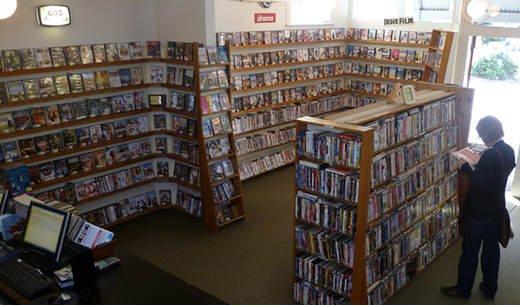Dear Andrew, I hope you’ve been having a better week at Aro Video.
Hearing your interview on Kim Hill on the weekend, you talked about the video store and physical media as "a sunset industry". The sun is indeed setting on one system of value; that is, hard cash in exchange for hard media. But for anyone wondering why a video store might be worth saving, I wanted to outline what Aro Video means to CIRCUIT and many of the artists we represent.
When I arrived in Wellington 20 years ago I quickly found myself living with a number of artists and film-makers. As a group, we lapped up the stores output of worldwide arthouse cinema, b-grade cult artefacts and so on; a default education simply through watching.
Later on, some of these artists made movies of their own; Gavin Hipkins’ Erewhon screened at the New Zealand Film Festival two years ago, a gallery version now resides in the collection of the Auckland Art Gallery. In 2009 I screened Michael Brown’s Falling Out at the Hamburg Film Festival. Another one of our gang, (and like Brown, a former Aro Video staffer) Bryce Galloway, works at an intersection of video and performance, and lectures a new generation of artists at Massey School of Fine Arts.
Erewhon (Trailer) (2014) Gavin Hipkins
As for myself, I started CIRCUIT in 2012, and since then we’ve made it possible for artists to work in the cinematic format; this past year six new commissions showed at the London Film Festival as part of their Experimenta weekend alongside work by Tacita Dean and other names more commonly associated with the gallery world.
Could the cinema be reclaimed as an artists’ medium? These six new CIRCUIT commissions mentioned above were each made in response to the work of Joanna Margaret Paul, an artist whose film-making drew on the physical, bodily tradition of experimental film. The six commissioned responses will shortly be installed at the Govett Brewster/Len Lye Centre; an institution that more than any understands the connection between art and cinema. Internationally, recent UK Turner Prize winners include film-works by Luke Fowler and Elizabeth Price. Next year the Adam Art Gallery screens Matthew Barney’s six hour River of Fundament at the Embassy Cinema.
And what about the question for artists of distribution? I'm thinking particularly here of Campbell Walker, Colin Hodson, Alexander Greenhough and others; the self-described "Aro Valley film movement", not to mention the political documentaries of Vanguard Films and others. Critical Cinema. What did it mean to these makers to have their work available and given the status of other titles on the shelf?
As I write about the influence of Aro Video on my peer group I’m also conscious that I’m talking about a generation no longer in their 20s. However, as international trends noted above demonstrate, cinema is a contemporary artistic medium. In this climate, Aro Video’s assets are many; a base of connoisseurship and 22,000 titles instore versus 2000 online for Netflix.
And while anyone can search online for a pirated title, how many people even know what they're looking for to begin with? Having someone you can trust amass a browsable collection of essential cinema is an act of curation. That it sits on a physical shelf rather than online simply engages with another mode of encounter basic to human engagement.
Beyond numbers, the value of Aro Video’s collection should not just be articulated as the intersection of a declining model of physical distribution, but celebrated as part of the nexus of contemporary artistic development. Of course, none of this pays the rent. But if buying the store's premises and gifting it to Aro Video made it viable financially, it seems entirely in keeping with the modes of private support active in the fine art community that a private benefactor step in and lend some assistance to keep this cultural treasure alive.
